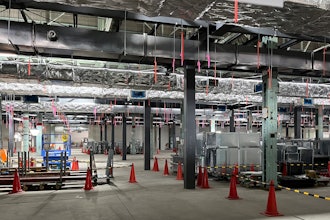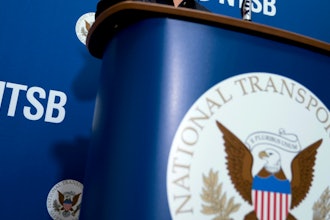WASHINGTON (AP) -- After a drunken driver on a California highway back in 1968 slammed into a bus carrying passengers to Las Vegas, killing 19, investigators said a lack of seat belts contributed to the high death toll. But 45 years later, safety advocates are still waiting for the government to act on seat belts and other measures to protect bus passengers.
Over the years, the National Transportation Safety Board has repeated its call for seat belts or some other means to keep passengers in their seats during crashes involving the large buses used for tours, charters and intercity passenger service. About half of all such motorcoach fatalities are the result of rollovers, and about 70 percent of those killed in rollover accidents were ejected from the bus.
The board has also repeatedly recommended stronger windows that don't pop out from the force of a collision and help keep passengers from being ejected, and roofs that withstand crushing. Those recommendations are nearly as old as the seat belt recommendation. No requirements have been put in place, even though all have long been standard safety features in cars.
Hundreds of motorcoach passengers have died and even more have been injured, many severely, since the board made its initial recommendations. Victims have included college baseball players in Atlanta, Vietnamese churchgoers in Texas, skiers in Utah, gamblers returning to New York's Chinatown, and members of a high school girls' soccer team en route to a playoff match.
"In 1998, my father was launched like a missile (out) a bus window and landed on his head on pavement. He is now permanently brain damaged and cannot even take care of himself," one woman wrote regulators, urging them to act. "This issue has been around for decades and it needs to change, NOW, before more people die or are severely injured like my father."
In 2009, the safety board said government inaction was partly responsible for the severity of injuries in a rollover crash near Mexican Hat, Utah, which killed 9 skiers and injured 43. Then-Transportation Secretary Ray LaHood promised the department would act to improve motorcoach safety, including requiring seat belts. Last year, when that still hadn't happened, Congress wrapped bus safety improvements into a larger transportation bill, which was signed into law. Regulations requiring seat belts on new buses were due in September, but are still under review by the White House Office of Management and Budget.
Other regulations on windows and roofs are due by Sept. 30, 2014, but safety advocates said they doubt the government will meet that deadline since it is less than a year away and regulations haven't even been proposed, let alone made final.
A spokeswoman for the National Highway Traffic Safety Administration didn't reply to an Associated Press request for an explanation of the holdup.
"Consumers have come to expect seatbelts in all motor vehicles; the regulator needs to get with the program and establish requirements that are long overdue. This is a simple issue: restraints save lives," NTSB Chairman Deborah Hersman told The Associated Press.
The delays are "unacceptable," said Sen. Sherrod Brown, D-Ohio, co-author of the bus safety provisions. He noted "safety measures like seatbelts are neither exotic nor complicated, and they are not new."
Motorcoaches typically cost between $350,000 and $500,000, according to the American Bus Association. Seat belts would add about $13,000 to the price of a new bus.
Safety advocates compare the buses to commercial airlines, which have even fewer deaths and injuries but still require passengers to buckle up. The nation's fleet of 29,000 commercial buses transports over 700 million passengers a year, roughly equivalent to the U.S. airline industry.
"These motorcoaches carry over 50 people. This is the over-the-road regional airline for some people," said Jackie Gillan, president of the Advocates for Highway and Auto Safety.
So far this year, 23 people have been killed and 329 injured in crashes, according to the organization's unofficial tally.
Seat belts have been required on motorcoaches in Europe and Australia since the 1990s.
Commercial bus operators fought seat belts for decades, but opposition began to weaken after a high-profile accident in 2007 in which a bus carrying Ohio's Bluffton University baseball team plummeted off a highway overpass near Atlanta. Five players, the bus driver and his wife were killed. Twenty-eight others were injured, including some students who are still trying to put their lives back together seven years later, said John Betts of Bryan, Ohio, whose son, David, was among those killed.
Bus manufacturers have recently begun including seat belts on most new buses anyway, said Dan Ronan, a spokesman for the American Bus Association.
But buses are typically on the road for about 20 to 25 years. Even if the government were to issue regulations tomorrow, it would likely be years before all have safety enhancements.
The industry opposes requiring that existing buses be retrofitted with seat belts. Seats not designed for them may not be strong enough to withstand the repeated pulling of straps, it says. Retrofitting is also more expensive than adding belts to new buses.
Generations of buses have come and gone without seat belts since the 1968 accident on a Mojave Desert highway near Baker, Calif., that prompted NTSB's first recommendation. In that collision, autopsies later showed most of the passengers survived the crash, but were badly injured and unable to escape the fire. If the bus had seat belts, it is likely that more passengers would have escaped because their injuries would have been less severe and they would have been less disoriented, the safety board said.
"We have worked too hard for too long for such a common-sense thing to be held up by people that don't see it as significant," said Betts, who lobbied to get the legislation passed. "If their son or daughter or wife or husband were killed in a motorcoach accident, perhaps that would get it off their desk."






















